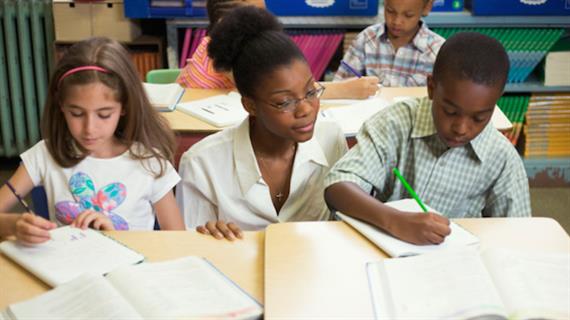If you teach reading, English or even social studies, chances are you’ve had a conversation about close reading in the last few months. While the topic was once reserved for university classrooms, close reading has come to K–12 and is here to stay, thanks to the Common Core State Standards.
The funny thing is, the standards don’t have much to say about close reading outside of requiring that students “read closely” to understand text (ELA Anchor Standard 1) and that students who have mastered the standards are able to “undertake the close, attentive reading that is at the heart of understanding and enjoying complex works of literature” (p. 3).
So why is everyone talking about it?
In short, close reading has become an education buzzword. As Chris Lehman points out, the term “close reading” has been applied to everything from independent reading to read alouds. All of those misapplications get in the way of what is actually a really valuable strategy.
Close reading is an interaction that involves observation and interpretation between the reader and a text. It means rereading and reflecting to come to new conclusions and understandings about the ideas that a text sets out. Timothy Shanahan defines close reading as “an intensive analysis of a text in order to come to terms with what it says, how it says it, and what it means.”
Students don’t naturally know how to “do” close reading, and for many, purposefully rereading isn’t a habit. So, close reading lessons incorporate:
- Short texts that are read and reread for different purposes to deepen understanding.
- Minimal frontloading so that students do the “heavy lifting” of comprehension and analysis (though, depending on the text, teachers may provide some preteaching).
- A focus on the reader’s experience with the text, whether that’s analysis, evaluation or synthesis.
Building off the idea (from Adler and Van Doren’s classic How to Read a Book) that every time we read, we enter a conversation with the author, I imagine close reading to be the most intense conversation that you can have. The kind of conversation where you are leaning across the table with your hand on your chin, so focused on what the person across from you is saying that you block out everything else. The kind of conversation that necessitates a back-and-forth with questions and clarifications before you really understand and can respond. The kind of conversation that you walk away from with insights and understandings that have a lasting impact.
A reading strategy defined by “intense, focused” reading and rereading can seem arduous. Especially when paired with the expectation around complex texts, close reading sounds like, well, work. And for too many students, as Donalyn Miller writes in The Book Whisperer, reading has become the “work” of school. Close reading, I think, has the potential to be just another task that students have to do between arrival and dismissal, or it can become a powerful skill that students turn to when they’re confused, inspired or intrigued.
It’s the start of a new school year, a time when we have an opportunity to shape the conversation about books. Let’s take close reading and the Common Core (or other standards) and help students have conversations with books that resonate far beyond the page.
Samantha Cleaver is an education writer, former special education teacher, and avid reader. Her book, Every Reader a Close Reader, is scheduled to be published by Rowman and Littlefield in 2015. Read more at her blog www.cleaveronreading.wordpress.com.
